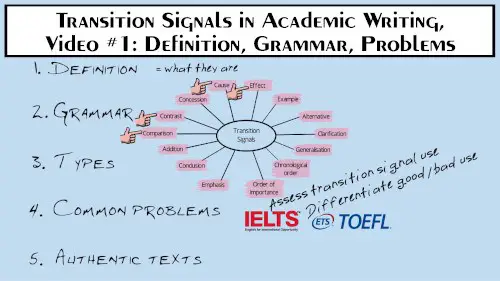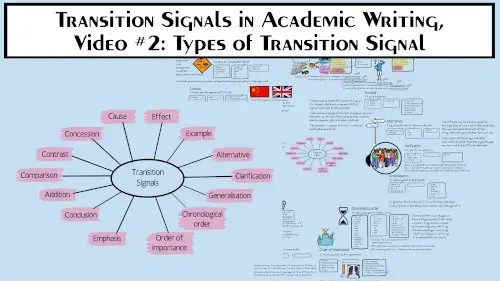Show AWL words on this page.
Show sorted lists of these words.


 







|
 Podcast is loading. Problems? Too slow? You can also access the Podcast by
clicking here.
Podcast is loading. Problems? Too slow? You can also access the Podcast by
clicking here.This message will disappear when then podcast has fully loaded.
Transition signals are useful in achieving good cohesion and coherence in your writing. This page gives information on what transition signals are, the grammar of transition signals, and different types of transition signals. There is also an example essay at the end in which you can highlight the different types of transition signal, as well as some exercises to help you practice this area.
What are transition signals?
Transition signals, along with repeated words and reference words, are one of the main ways to achieve good cohesion and coherence in your writing. They are therefore a way to help ensure that your ideas and sentences cohere or 'stick together'. Transition signals are used to signal relationships between ideas in your writing. For example, the transition signal 'for example' is used to give examples, while the word 'while' is used to show a contrast. In addition, there are phrases like 'in addition' for adding new ideas. Likewise there are words such as 'likewise' to connect similar ideas.
Grammar of transition signals
Broadly speaking, transition signals can be divided into three types:
Sentence connectors are used to connect two sentences together. They are joined by a full-stop (period) or semi-colon, and are followed by a comma. The following are examples of sentence connectors.
- Transition signals are very useful. However, they should not be used to begin every sentence.
- Transition signals are very useful; however, they should not be used to begin every sentence.
- Contrast signals are one type of transition signals. In addition, there are others such as compare signals and addition signals.
- There are three main ways to improve cohesion in your writing. First, you can use transition signals.
Clause connectors are used to connect two clauses together to form one sentence. They are joined by a comma. The following are examples of clause connectors.
- Transition signals are very useful, but they should not be used to begin every sentence.
- Although transition signals are very useful, they should not be used to begin every sentence.
- Contrast signals are one type of transition signal, and there are others such as compare signals and addition signals.
Other connectors follow different grammar patterns. Many are followed by noun phrases. Some are verbs and should therefore be used as verbs in a sentence. The following are examples of other connectors.
- Despite their importance in achieving cohesion, transition signals should not be used to begin every sentence.
- Good cohesion is the result of using repeated words, reference words, and transition signals.
- It is clear that careful use of transition signals will improve the cohesion in your writing.
- Contrast signals are one type of transition signal. Another type is comparison signals.
Types of transition signals
Below are examples of different types of transition signals. They are divided by type, and sub-divided according to grammar. More information on some of these is given in relevant essay sections. You can also check out the second YouTube video on the EAP Foundation YouTube channel, which looks at types in more detail, with example sentences.
To introduce an additional idea
Sentence connectors
- also
- besides
- furthermore
- in addition
- moreover
- additionally
Clause connectors
- and
- nor
Other
- another (+ noun)
- an additional (+ noun)
To compare
For more on comparison signals, see the compare and contrast essays section.
Sentence connectors
- likewise
- similarly
- equally
- in the same way
Clause connectors
- and
- both... and
- not only... but also
- neither... nor
- just as
Other
- as... as
- like/alike
- just like
- to be similar to
- to be alike
- to be similar
To contrast
For more on contrast signals, see the compare and contrast essays section.
Sentence connectors
- however
- in contrast
- in/by comparison
- on the other hand
Clause connectors
- but
- whereas
- while
Other
- compared to/with
- to be different (from)
- to be dissimilar
- to be unlike
- to differ (from)
To show concession
Concession transitions show an unexpected result. They are similar to but not the same as contrast transitions. E.g. Although the sun was shining, he took an umbrella to work. [The sun shining means taking an umbrella is unexpected.]
Sentence connectors
- however
- nevertheless
- nonetheless
- still
Clause connectors
- but
- yet
- although
- even though
- though
Other
- despite (+ noun)
- in spite of (+ noun)
To introduce a cause/reason
For more on cause signals, see the cause and effect essays section.
Sentence connectors
- for this reason
Clause connectors
- for
- because
- since
- as
Other
- to result from
- to be the result of
- due to
- because of
- to be the effect of
- to be the consequence of
- as a result of
- as a consequence of
To introduce an effect/result
For more on effect signals, see the cause and effect essays section.
Sentence connectors
- as a result
- as a consequence
- consequently
- hence
- thus
- therefore
Clause connectors
- so
Other
- to result in
- to cause
- to have an effect on
- to affect
- the cause of
- the reason for
To give an example
Sentence connectors
- for example
- for instance
- in this case
Other
- such as (+ noun)
- like
- an example of (+ noun)
- to demonstrate
To show chronological order
Sentence connectors
- first, second, etc.
- first of all
- then
- next
- now
- then
- soon
- last
- finally
- previously
- meanwhile
- gradually
- after that
- since
- then
Clause connectors
- after
- as
- as soon as
- before
- since
- until
- when
- while
Other
- the first, the second
- the next, the last, the final
- before (lunch etc.)
- after (the war etc.)
- since (1970 etc.)
- in the year (2000 etc.)
To show order of importance
Sentence connectors
- above all
- first and foremost
- more/most importantly
- primarily
Other
- a more important
- the most important
- the second most significant
- the primary
To show an alternative
Sentence connectors
- alternatively
- otherwise
Clause connectors
- or
- if
- unless
To identify or clarify
Sentence connectors
- that is
- in other words
- specifically
Other
- namely
- i.e.
To reinforce
Sentence connectors
- in fact
- indeed
- of course
- clearly
To conclude
Sentence connectors
- all in all
- in brief
- in conclusion
- in short
- in summary
Other
- to summarise
- to conclude
- It is clear that...
- We can see that...
- The evidence suggests...
- These examples show...
Example essay
Below is an example essay. It is the one used in the persuasion essay section. Click on the different areas (in the shaded boxes to the right) to highlight the different types of transition signal in this essay.
Title: Consider whether human activity has made the world a better place.
Examples |
Addition |
|
Contrast |
Reason |
|
Alternative |
Conclude |
History shows that human beings have come a long way from where they started.
They have developed new technologies which means that everybody can enjoy luxuries
they never previously imagined.
However, the technologies that are temporarily making this
world a better place to live could well prove to be an ultimate disaster
due to, among other things, the creation of nuclear weapons,
increasing pollution, and loss of animal species.
The biggest threat to the earth caused by modern human activity comes from
the creation of nuclear weapons.
Although it cannot be denied that countries have to
defend themselves, the kind of weapons that some of them currently possess are far in excess of what is needed for
defence. If these weapons were used, they could lead to the destruction of the entire planet.
Another harm caused by human activity to this earth is
pollution. People have become reliant on modern technology, which can have adverse effects on the environment.
For example, reliance on cars causes air and noise pollution. Even seemingly innocent devices,
such as computers and mobile phones, use electricity, most of which
is produced from coal-burning power stations, which further adds to environmental pollution.
If we do not curb our direct and indirect use of fossil fuels, the harm to the environment may be catastrophic.
Animals are an important feature of this earth and the past decades have witnessed the extinction of a considerable number of
animal species. This
is the consequence of human encroachment on wildlife habitats,
for example deforestation to expand human cities. Some may argue that such
loss of species is natural and has occurred throughout earth's history.
However, the current rate of species loss far exceeds normal levels, and is threatening to become
a mass extinction event.
In summary, there is no doubt that current human activities
such as the creation of nuclear weapons, pollution, and destruction of wildlife, are
harmful to the earth. It is important for us to see not only the short-term effects of our actions, but their long-term
effects as well.
Otherwise, human activities will be just another step towards destruction.
Transition signals |
Examples |
Addition |
Contrast |
Reason |
Alternative |
Conclude |
Checklist
Below is a checklist for transition signals. Use it to check your own writing, or get a peer (another student) to help you.
| Item | OK? | Comment |
| There is good use of transition signals, without being overused (not every sentence!) | ||
| The grammar is correct (e.g. using sentence connectors to join sentences with a full-stop (period), using clause connectors to join two clauses, using other connectors correctly e.g. 'due to' + noun) | ||
| There are different types of transition signal |
Next section
Find out how more about hedging in the next section.
Previous section
Go back to the previous section about cohesion.
You need to login to view the exercises. If you do not already have an account, you can register for free.









